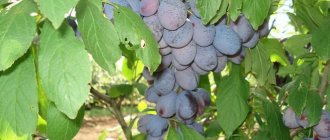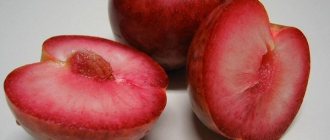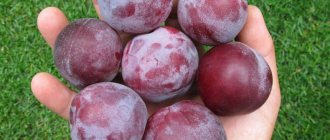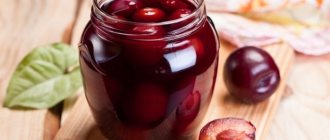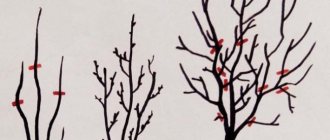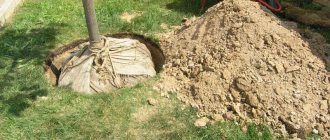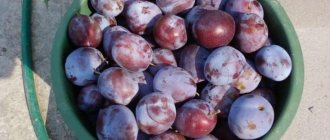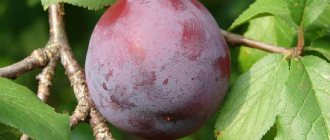Characteristics of varietal groups of domestic plums
From the 2000 varieties of domestic plums, every gardener can select his favorite one and plant this precious gift from the 4th century BC in the garden.
Modern varieties of plums, depending on the external structure, color and quality characteristics of the fruit, are divided into 4 groups.
- Hungarians, as a rule, have dark-colored fruits of medium size and elongated shape. They are distinguished by high sugar content of fruits. The flesh is elastic, with a delicate dessert taste. Most varieties are self-fertile and do not require pollinating companions. The varieties tolerate the winter cold of the southern regions well, but are susceptible to freezing during long frosty periods.
- Renklody - a group of varieties with green fruits of different shades with a rounded shape of a juicy fruit. The pulp is sweet and so juicy that the fruits are not used for drying, unlike Hungarian ones. Basically, green varieties are consumed fresh and for making compotes and juices. When breeding plums of this variety, be careful. They are self-fertile and require pollinators. They are characterized by low winter hardiness. In the central zone of the European part of Russia, due to weather conditions, they are rarely grown.
- Egg plums with a typical egg-shaped fruit. The color of the fruits is yellow in different shades, covered with a thick waxy coating. Recently, varieties with blue fruits and other shades have appeared. The pulp of the fruit is moderately juicy and tender. The varieties are winter hardy and self-fertile. The varieties are usually tall, which makes care difficult, and are not resistant to diseases.
- Mirabelle is a group of varieties characterized by comparatively small fruit (similar to cherry plum). The taste of the fruit is sour and sweet and sour. In private gardening they are grown less frequently. Sour varieties are used in winter preparations instead of vinegar.
Since the 20th century, breeders, creating new varieties, have used interspecific crossing (for example: plum with apricot, etc.), which makes it possible to obtain low-growing hybrid crops with increased frost resistance, resistance to summer droughts and high temperatures, with good quality and marketable fruit. . The development of varieties with new qualities made it possible to promote the culture not only throughout central Russia, but also into the northern regions.
Features of culture
Frost resistance is the main advantage of the variety. The “Cooperative” plum tolerates Siberian temperatures down to minus 40 degrees, and at the same time grows well in the southern regions.
Sensitivity to lack of watering is a disadvantage of the variety. Trees constantly require additional dosed watering, otherwise they slow down in growth and lag behind in their other characteristics.
Resistance to diseases and pests is average. The general immunity of seedlings is not bad, but they are susceptible to rot, plus insect pests are also not averse to settling on the surface of plums.
Plum Yellow
People are usually accustomed to seeing purple and blue plums on tables and store counters. But there are varieties that have completely different colors. Yellow plum is one of these. It was obtained by crossing cherry plum and wild plum. This hybrid, due to its sweetish taste, is suitable both for preparing various sweets and for fresh consumption. Let's look at some varieties of yellow plum.
Firefly
- Collective farm farmhouse
- Lighthouse
- Record
- Yield yield
Rules for selecting plum varieties for the garden
Early varieties of plums allow you to enjoy your favorite fruits until mid-August. They are very juicy, but not overly sweet. Let us describe some representatives of this group.
Eurasia
“Eurasia” is not capable of pollinating on its own.
- Volga beauties
- Memory of Timiryazev
- Renklod Kolkhozny
- Lighthouse
- The Golden Fleece
Starting
When buying plum seedlings for a summer residence, you must immediately ask the seller about the main characteristics of the variety. They should be in the accompanying advertising note or in separate catalogs on the counter. You can familiarize yourself with the varieties in advance via the Internet and then buy the pre-selected one. To avoid being deceived, you should not buy planting material on the sides of highways or in the market. It is best to buy from agricultural companies where they grow seedlings for sale.
When purchasing a seedling, the accompanying note must indicate:
- name of the variety or hybrid,
- zoning,
- the need for pollinators,
- maturation group (early, middle, late),
- the year of the beginning of fruiting,
- productivity,
- frost resistance,
- resistance to diseases and pests (which ones),
- keeping quality,
- separating the pulp from the pit.
At the dacha, it is enough to have one tree of different ripening groups in order to be provided with these fruits for fresh consumption all summer and preparations for the winter.
Early plum varieties
The ripening period of early varieties covers the last ten days of July - the first ten days of August. They are distinguished by the formation of high yields. Of the new early varieties, we can recommend Morning, Opal, and Renklod collective farm. Very tasty productive varieties Kooperativnaya, Zarechnaya rannyaya, Krasny Shar, Record, Skoroplodnaya and others.
Medium plum varieties
Late plum varieties
The ripening period of late varieties begins at the end of August and lasts until the third ten days of September. The varieties are characterized by increased frost resistance and are used mainly for preservation. Of the new varieties, we can recommend Renklod Tambovsky, Memory of Timiryazev. It should be noted that the plum varieties Bogatyrskaya, Zhiguli, Svetlana, President and others are widely used in private gardens.
Of course, it is impossible to list all the varieties in the article (there are more than 2000 of them) and give their characteristics. It is most advisable to get acquainted with the cataloged varieties of different ripening periods, their characteristics and choose your favorite variety. It should be noted that on one plum tree you can successfully graft several varieties into skeletal branches and get a whole garden on one tree. The following composition and beneficial properties of plum fruits will confirm the need to grow this crop in the country garden.
Plum Renclod
Under this name, different varieties of the same species are united - domestic plum. Western Europe is considered to be the homeland of Renclod plums. These are trees with a height of 5 to 7 m. The berries are egg-shaped. Their color, depending on the variety, can range from yellow-green to purple. The peel is matte.
This group received particular value for its taste. The fruit inside is soft, juicy and sweet. Productivity directly depends on weather conditions. They can bear fruit even once every few years.
- Green
- Enikeeva
- Soviet
- Blue
- Prizedentsky
- Michurinsky
- Karbysheva
- Kuibyshevsky
- Leah
- Tatar
- Ulena
Read more: Chamomile chrysanthemums – OgorodGuru
Let's look at some of them in more detail.
Kharitonovskaya
- Renklod Green
- Donetsk early
- Renclod Altana
- Hungarian Donetsk
Plum agricultural technology
Zoned varieties of plums are most widespread in the European zone. A feature of plums is a long dormant period, which allows the crop to withstand temperature changes from warming to recurrent frosts and vice versa without damage. The cool European summer, sometimes with heavy rains, does not prevent the crop from producing high-quality, high yields of tasty fruits.
It is better to plant plum seedlings in the spring. The plum root system consists of skeletal branches of the 1st-2nd order, which mainly serve as conductors and fibrous branches that overgrow the main roots. They perform a suction function and are located in the upper 40 cm layer of soil. Plum seedlings planted in April have time to develop a root system and adapt to the conditions of the growing area during a long warm period. When planted in autumn, they often freeze or dry out and do not bloom in the spring.
Plum trees should not be planted in low areas with close groundwater. If the water layer is located 1.4-1.5 m from the soil surface, the plum tree will die early, although it can bear fruit in one place for more than 20-25 years.
If the area is low, the groundwater is close, and there is no other place, then you can prepare a mound for draining. Weave an area with a diameter of up to 3 m and a height of up to 1.0 m with willow twigs. Use pebbles and crushed stone to fill a 10-15 cm layer of drainage to drain excess water and fill it with a mixture of local typical soils of neutral acidity.
On a flat or elevated surface, if the soil is clayey or heavy, it is necessary to fill the planting hole with a mixture of light soil soils. By adding leaf soil, humus, high peat, sandy loam soil and a sufficient amount of fertilizer. Such a soil pit must have a diameter of at least 1.0x1.0x1.0.
To remove soil acidification, they need to be limed. The amount of lime is:
- on soddy-podzolic soils 500-800 g sq. m,
- on light soils that have received only mineral nutrition for a long time (mineral fertilizers, when applied over many years, acidify the soil), 300-400 g sq. m,
- on heavy soils (clayey and loamy) from 0.8 to 1.0 kg/sq.m. m area.
In our conditions, the plum tree grows up to 4-6 meters and loves the sun. Its root system is quite superficial, which causes an increased requirement for moisture, and sometimes also abundant formation of shoots. It begins to bear fruit in the 3-7th year, longevity is 20-60 years, service life is 15-20 years.
All plums bloom early, when the threat of frost is real, and therefore you need to choose a protected place with light, fertile soil. It should also be taken into account that plums have complex pollination requirements: some varieties are self-fertile, some are partially self-fertile, and some are self-sterile. The latter certainly need pollinators, but even self-fertile ones planted next to them significantly increase the yield. So plant several trees of different varieties at once, having consulted in advance about their flowering dates and pollination possibilities.
Plant plum trees in early spring before the buds open. The planting pattern is 3x4 m. The planting hole is 60 cm deep and 40 cm wide. Maintenance consists of loosening and mulching the soil, removing weeds and growth, timely pruning, watering and fertilizing, checking for the presence of pests and diseases. If a bountiful harvest is expected, in order to get larger fruits and prevent branches from breaking, you can thin out the ovaries by carefully cutting them with pruners and install supports.
About the choice of varieties, let’s turn a little further to the advice of famous gardeners. If the garden conditions do not fully meet the requirements, you can take seedlings obtained from the root shoots of old varieties (they are able to regenerate in the event of frost), or locally grown seedlings, as they are more resistant, especially in the second or third generations.
If you want to have a variety with insufficient winter hardiness, you can graft it into the crown of varieties that are reliable in local conditions. And also, if the site is located in conditions unfavorable for plums, rely on varieties and forms of damsons and sloe, which are more hardy. Just don’t rashly purchase varieties of Far Eastern plums that are remarkable in many respects (winter hardiness, productivity, beautiful fruits).
It is impossible not to note the decorative advantages of plums, especially Russian and Chinese plums. The first amazes with the abundance of flowers and then fruits, the second with its ability to bloom in the middle of winter, of course not the Russian one. But in the Chinese or European winter, from December to April, it is quite possible to “enjoy the delicate plum flowers, whose corollas have opened in the snow.”
Plum varieties for our gardens
Advice from V. Morozov: Experience shows that for the very harsh conditions of my garden there are still no varieties of plums suitable for frost resistance, with the exception of old ones, like 'Tula Black' or 'Skorospelka Red'. But tests of more than 30 varieties of Russian plum gave inspiring results. 'Zlato Scythians', 'Kuban Comet', 'July Rose', 'Cleopatra', 'Scarlet Sails', 'Gift to St. Petersburg', 'Gift to the Giant Garden', 'Rocket Seedling', 'Alyonushka' and many others regularly and bear fruit abundantly, delighting with beautiful, juicy and tasty fruits.
Varieties of folk selection: 'Skorospelka Red', 'Hungarian Moskovskaya', 'Tula Black'. 'Zhiguli' selection by E. P. Finaev; 'Eurasia' (A. N. Venyaminov); 'Renclad Tambovsky', 'Egg Blue', 'Violet', 'Smolinka', 'Enikeevskaya', 'Skoroplodnaya' (Kh. K. Enikeev, S. N. Satarova); 'Blue Gift', 'Morning', 'Interesting' (V.S. Simonov);
Russian plum: 'Found', 'Kuban Comet', 'Huck', 'Tent', 'Columnar', 'Traveler' (Crimean OSS); 'Zarnitsa', 'Yarilo', 'Monomakh', 'Zlato Scythians', 'Nesmeyana', 'Cleopatra' (Timiryazev Academy); 'Promen', 'Vetraz', 'Mara', 'Asaloda', 'Vitba' (Institute of Fruit Growing of the National Academy of Sciences of Belarus). (Isaeva I.S. Garden of the XXI century. M., ROSMEN, 2005)
Advice from V. Susov: For half a century of studying varieties in the Michurinsky garden of the Timiryazev Academy, I consider the best plums to be: 'Candy' and 'Cooperative' from the early ones, 'Mashenka' and 'Renklod Kharitonova' from the middle ones, 'Apukhtinskaya' and 'Rusinka' from the later ones; according to Russian plum: 'Kuban Comet' and 'July Rose' from the early ones, 'Vladimir Comet' and 'Tent' from the middle ones, 'Rocket Seedling' and 'Vaneta' from the late ones.
Read more: When and how to graft an apricot. Apricot grafting with cuttings in summer
I consider the varieties of V.P. Yagunov to be the most winter-hardy - 'Mashenka' and 'Dashenka'. These same varieties, as well as 'Alyonushka', produce the largest fruits; the most productive are 'Skoroplodnaya', 'Bogatyrskaya', 'Skorospelka Novaya'; the most delicious fruits are from 'Konfetnaya', 'Cooperative', 'Alyonushka', 'Mashenka', 'Bogatyrskaya' and 'Renkloda Kharitonova'.
(Susov V.I.. Promising varieties of fruit trees. M., 2009)
Plum Cooperative
Plum Kooperativnaya is a universal-purpose variety of early-medium ripening, obtained by crossing the Volzhskaya Krasavitsa and Gray Dove plums in 1993. It is characterized by high winter hardiness, productivity, a high level of resistance to various diseases and pests, unpretentiousness, early fruiting and good quality fruits. There are practically no disadvantages.
tree , with a spherical crown, leafy. Can reach a height of 4 meters. It begins to bear fruit at 3-4 years. The shoots are medium length, thick, straight. The leaves are green and dense. The winter hardiness of the tree, flower buds and root system is high.
The fruits are oval, large (weight 30-35 g), purple-red in color, very attractive in appearance. They ripen early, in the second ten days of August. The pulp is yellow-green, juicy, sweet and sour, aromatic. The taste qualities of the fruit according to the organoleptic method are very good: dry matter 15.11%, sugars 10.66%, acids 2.14%. The stone is medium-sized, easily separated from the pulp. Transportability of fruits is high. Perfect for all types of workpieces.
Soil and place for plum Cooperative. Suitable soil types for plums are soddy-podzolic, loamy, drained and limed to neutralize acid, and peat bogs. In cooler regions, you should choose fairly well-warmed areas for planting plums, where the snow begins to melt faster. If you decide to plant a plum on a slope, then it must be oriented south or southwest, but not north.
The soil in the area where you plan to plant a plum must be leveled; microdepressions and microdepressions are unacceptable, because they often accumulate melt and rain moisture, as well as cold air, which can negatively affect the plants. Do not use overly compacted substrates for planting; in such areas the soil often does not have sufficient air exchange; you should also not use gravel or rocky soils.
Plum planting Cooperative. You should start planting plums in the spring, but it is better to buy seedlings in the autumn. During this period, the choice of seedlings is significantly higher, it is easier to find the variety you like, and the quality of planting material is usually better.
Having purchased a seedling, you can bury it in the garden plot before planting. To do this, choose a place sheltered from cold winds where a lot of snow accumulates, dig an elongated hole, like a trench, and place the seedlings in it so that the root system and part of the trunk are in the soil. After this, the seedling must be sprinkled with soil, watered and covered with burlap or dry leaves, and covered with snow if there is a little accumulated snow.
Around mid-April, as soon as the snow melts and the weather is warm enough, the seedlings can be removed from the trench and planted on the site. Usually, plums are planted, depending on the region, from the second ten days of April to mid-May, but it all depends on the onset of a warm period and the readiness of the soil at the moment.
Planting plums in the spring is also favorable because the soil during this period is rich in moisture, and this, combined with above-zero temperatures, will allow the seedlings to quickly settle in a new place and acquire additional roots.
Having marked the area, we begin to prepare the soil; it is better to do this in advance, about a week before planting. The soil on the site should be dug deep with a shovel full, leveled, and then the holes necessary for planting seedlings in them should be dug. The size of the planting holes is usually slightly larger than the volume of the root system of the seedling. The roots should be freely located in the hole, without creases or bends. When digging a hole, set the top layer of soil, which is always more fertile, aside; it will then need to be placed in the base in order to provide additional nutrition to the roots. The seedling is placed on this nutritious soil, carefully straightening the roots, after which it is sprinkled with earth, periodically shaking the plant, holding it by the base of the trunk. This is necessary to get rid of voids between the roots. Immediately after planting, the soil is compacted and watered, using about a bucket of water for each seedling, and then the soil is mulched with humus in a layer of a couple of centimeters in order to retain moisture in the soil.
Plum planting scheme Cooperative. If you are planting several plum seedlings, then you need to retreat about three meters from each other, because the plum has a wide crown. It is necessary to retreat the same distance from other plants on the site so that the plum does not shade them.
Plum care Cooperative. In the future, caring for the seedlings is not complicated and consists of watering during dry periods, loosening the soil in the tree trunk and weed control. During the formation of the ovary, you can feed the plum with organic fertilizers. If the soils of your site are poor and contain insufficient amounts of basic elements, then they must be added. The drain itself will tell you about the lack of elements; you should take a closer look at the plants. For example, a lack of potassium in the soil leads to a change in the color of the foliage; the foliage becomes discolored and turns gray. If there is not enough nitrogen in the soil, the edges of the leaves turn yellow. The edges of plum leaves turn yellow also because there is not enough moisture in the soil; the plant simply cannot absorb elements from the soil, even if they are there in sufficient quantities.
Lack of moisture can also lead to plants shedding part of the ovaries, which threatens to reduce yields and deteriorate the quality of fruits.
However, there is no need to rush into fertilizing plums. You should start applying complex fertilizers to plum trees from about the third year of the seedling’s life in a new place. Per square meter of tree trunk circle, usually add 5-6 kg of manure, leaf humus or compost, as well as microelements in the amount of 30-35 g of superphosphate and 12-15 g of ammonium nitrate. As soon as the plants begin to bear fruit, the dose of fertilizer can be approximately doubled. When applying fertilizers, try to focus on nitrogen in the spring, and phosphorus and potassium in the fall. In the fall, nitrogen fertilizers cannot be applied, because they stimulate the active growth of shoots, and this can lead to their freezing in the winter, because they simply do not have time to ripen.
During the period of mass flowering, especially if it is strong, it will be successful to feed the plants with liquid fertilizer, which is made by mixing ammonium nitrate (7-10 g), super phosphate (15-20 g), potassium salt (5-7 g) and dissolving everything it's in a bucket of water. This volume is usually consumed per square meter of tree trunk. Additional fertilizing can be carried out during the season, often using an infusion of mullein or bird droppings.
By the way, applying fertilizers cannot be called a simple agricultural practice; this is an important stage in caring for plants and it has its own subtleties that you definitely need to know. In addition to what we have already mentioned, it is worth remembering that in cool years, with plenty of rain, you should refrain from using large doses of nitrogen fertilizers, but the amount of potassium and phosphorus, on the contrary, can be increased.
Sanitary pruning of plums should be carried out annually, starting from about the fifth year of the plant’s life, in early spring, usually a month before buds open. At this time, remove all dry shoots, frozen ones, if any, too thin and those that grow deep into the crown, thickening it. By the way, plum fruits form on last year’s growths and on short overgrowing shoots, so you need to be careful when carrying out sanitary pruning. Good and timely pruning will allow the plants to produce good yields; the fruits on a sufficiently illuminated crown will ripen together, so that they can be collected in one or two steps and used for food both fresh and processed.
In wet years, cracking of plum fruits sometimes occurs. In this form they are not stored at all, and their taste is worse. To prevent cracking of the fruits, in wet years with a lot of rainfall, the fruits should be harvested unripe. There is no need to be afraid of such harvesting; the fruits ripen very well, acquiring the appropriate taste and color, being placed in shallow boxes or flat baskets. From the laying of fruits that begin to ripen to their complete ripening, it usually takes 7-8 days. Ripe fruits of good quality and ripened plum fruits are usually stored in a regular household refrigerator for 14-16 days.
The plum tree will definitely respond to good self-care with excellent harvests; by the way, you won’t have to wait long for the first harvest, even if it’s small; approximately two to three years after planting the seedling, the tree will produce several dozen fruits, the number of which will increase from year to year.
Reproduction of plum Cooperative Root shoots are formed in plums from adventitious buds, which are located on the roots of the plant . The root shoots, however, are not always subject to complete destruction; if, for example, your seedling was obtained by rooting green cuttings or layerings, then the root shoots will have all the signs of a cultivated plant, and after carefully digging it up and separating it from the mother roots, it can be planted to a new place.
Planting seeds. Usually the seeds are used only for growing seedlings for rootstocks. We take good, healthy seeds, wash them, remove the pulp and soak them for 4 days, while changing the water and stirring the seeds. Then dry it and store it in a glass jar. Before planting, plum seeds are stratified. Mix them with moistened, but not damp filler (sand, sawdust), keep for about 180 days at a temperature of +1 to -10 ° C. Seeds are sown in the fall before winter or at the end of April, after frosts have passed. The distance between seedlings is about 10 cm, between rows - about 70 cm, to a depth of about 70 cm. Grafting. To successfully graft, you need to grow a seedling-rootstock of very winter-hardy varieties of plums and sloe. After about a year, you can start vaccinating them. You can buy shoots for grafting or cut them from your own trees. Seedlings are grafted during the period of active sap movement, that is, in the spring, in April-May, or in the summer, in July-August. Typically, cuttings are grafted in the spring, and bud grafting is done in the summer. Root growth. In the fall, you cut the root that connects the mother plant with the shoot, and in the spring the shoots with roots are dug up and planted in the right place. Root cuttings. For a young tree, roots are dug up at a distance of about 1 m from the trunk; for an adult, about 1.5 m. Roots are taken about 1.5 cm thick and about 15 cm long. If dug up in the fall, they are stored either in a dug trench about 50 cm deep, sprinkled with peat and coarse river sand 1:1, or in the basement in layers of wet sawdust and moss. At the end of April - beginning of May, the cuttings are planted under a film in prepared soil (one part sand to three parts peat) obliquely or vertically. The distance between the cuttings is about 5 cm, and between the rows is 10 cm. They fall asleep about 5 cm, then water. The upper ends should be buried 2 cm and mulched with sawdust or peat. While there are no first shoots, you need to shade the cuttings and not let them dry out. Leave the strongest shoot if there are several of them on the cutting. Feed with organic fertilizers (nitrogen fertilizers, slurry) several times a season. The next winter they are replanted and grown to 1.5 m, after which they are transplanted into the garden.
Use of plum fruits Cooperative. A universal-purpose variety, perfect for fresh consumption, transportation and various preparations.
Plum Hungarian
Hungarian plums are a group of varieties that can grow in different climatic conditions. Their agricultural technology is not complicated, so this group is suitable for growing by novice gardeners.
Trees up to 6 m high. Their fruits are ellipsoidal in shape, different shades of blue and purple. The inside of the berries is dense and yellow. They bear fruit every year. Most Hungarian fruits do not require pollinator varieties to be planted with them.
The berries of this group of plants are used to make prunes. Hungarians bear fruit well, are resistant to drought, suitable for storage and transportation, but the first harvest can be harvested no earlier than 6 years after planting.
Stanley
To obtain prunes, this variety is most often used.
Planting plum seedlings
Planting holes, especially in low places or on artificial hills, are prepared in the fall (see description above). If the location is selected according to the crop’s location requirements, then when the snow melts, planting holes are dug at a distance of 2.5-3.0 m. The depth and diameter of the hole must correspond to the root system of the seedling.
The dug up soil (sometimes only the top layer) is mixed with 1-2 buckets of organic matter, 300-400 g of nitrophoska are added, and mixed well. A support stake is driven into the center of the hole, to which a plum seedling is then tied. Part of the mixture is poured into a mound into the planting hole. The roots are spread over the top of the mound and covered with the rest of the soil mixture.
Fill in 0.5 buckets of water, add soil to the edge of the planting hole, and compact it. It is important that the root collar is 3-5 cm above the soil level. A roller is formed around the perimeter of the planting hole and another 0.5-0.7 buckets of water are poured. After the water has drained, the soil surface is mulched with peat or any organic matter, except pine needles or pine sawdust. A plum seedling is tied through a figure eight to a support.
Diseases and pests
- Hole spot. The leaves are covered with brown spots, which are framed at the edges by a dark border. Then the diseased tissue falls out, forming through holes in the sheet. Spots may appear on the fruit, changing it. To combat this disease, plant debris should be collected and destroyed.
- Coccomycosis. Red-brown small spots form on the top of the foliage. A powdery coating with a pinkish tint appears at the bottom of the leaf. The disease causes leaves to fall off, and the affected fruits do not grow and dry out. To combat Cooperative, after flowering and harvesting, they are treated with “Hom”.
- Moniliosis. The branches become brown and wither, looking burnt. Gray growths appear on the affected fruits.
- Fruit mite. Because of it, the foliage falls off prematurely. Buds for the future harvest grow more slowly. To treat the disease, the tree trunk should be cleared of old bark. If there are too many pests, then it is worth treating the plant with insecticides (Karate, Fufanon).
- Eastern codling moth. Caterpillars move along young shoots, eating out their tunnels. Then the stem becomes brittle and dries out. They can also damage the pulp. To exterminate pests, the tree is treated with a solution of table salt (500-700 g per 10 liters of water) immediately after flowering.
Plum Columnar
This type of plum appeared in our country several decades ago. But it was “to the taste” of many gardeners. Its main difference can be considered an extremely narrow crown - 80 cm. Columnar plum varieties are convenient to plant in small areas, since they do not have spreading branches. But such plants have a significant drawback - they cannot tolerate low temperatures.
The columnar plum does not have a large number of varieties.
- Imperial (pink fruit)
- Mirabelle (yellow berries)
- Blue Sweet (purple fruit)
These are small trees, about 2 m high, producing up to 16 kg of fruit. They can be used both fresh and for jam, jam, etc. Fruiting begins at the 3rd year of life. Productivity is growing every year.
Imperial
Cooperative plum variety description photo reviews
The names of plum varieties are numerous. In this material we will dwell in detail on the most popular of them - self-fertile. What exactly is it about these plums that attracts gardeners the most?
The self-fertility of a plant is its ability to self-pollinate. Such a tree does not need either insects or a related crop in the neighborhood to set fruit.
In many self-fertile plants, the anthers are at the level of the stigma, and fertilization occurs when the flower has not yet opened.
This allows you to get a harvest even under unfavorable conditions: when a strong wind blows during the flowering of plants, the flight of bees and bumblebees is disrupted, etc.
https://www.youtube.com/watch?v=YXBndA4EybA
But you should know: without the participation of a pollinator variety, self-fertile plants produce only up to 50% of the available flowers. Only with the help of pollinating varieties can this figure be brought closer to 100%.
In addition, self-fertility is a variable trait. The same variety in one climate can be stably self-fertile every year, and in another region it can be partially self-fertile (only 20-30% of flowers are produced without pollinators).
Then the harvest will not live up to your hopes.
So, let's find out which self-fertile plum variety is best to plant in the middle zone and Moscow region so that the plant does not disappoint.
Anna Shpet
Large oval-shaped fruits ripen on a vigorous tree with a round or rounded-pyramidal crown. The color of the fruit is dark purple with a reddish tint and subcutaneous dots.
The skin is covered with a bluish waxy coating; it is easily separated from the pulp. The pulp is greenish-yellow or golden, dense, tender, juicy, fibrous, sweet with a slight sourness.
The fruits are suitable for fresh consumption and making jam, but are not suitable for freezing and production of dried fruits.
The frost resistance of the plant is average, so the variety is more popular in the south. However, after freezing, the tree recovers well, even frost damage is healed.
Although the variety is considered partially self-fertile, it produces a good harvest even without pollinators. And if you plant nearby plums of the varieties Washington, Hungarian domestic, Hungarian Italian, Victoria, Ekaterina, Raisin-Erik, Kirke, Rannyaya, Renklod green, Peach, then from an adult ten-year-old plant in a harvest year you can collect about 60 kg of fruit.
Among the disadvantages of the variety are weak resistance to disease, high crown (when harvesting from an adult tree you cannot do without a ladder), loose wood (trees often break in strong winds).
Hungarian Moscow, or Tsaritsynskaya
This late-ripening plum variety was bred in 1947 and recommended for cultivation in the Moscow region.
On medium-sized trees with a spreading spherical crown, round-oval or ovoid purple-red fruits ripen in the 6-8th year after planting.
The skin is thick, rough, with a bluish-violet waxy coating, the taste is slightly bitter. The pulp is dense, juicy, sweet and sour, amber yellow.
The fruits tolerate transportation well, but are consumed mainly in processed form, since their taste is slightly inferior to other varieties. Hungarian Muscovy is highly valued for its very high yield, especially when planted together with Red Skorospelka.
Yellow self-fertile
On a fairly tall tree with a lush spreading crown, already in the third year after planting the seedling, round yellow fruits ripen. They have a thick skin with a waxy coating and sour-sweet flesh of a light yellow color. The fruits are well transported. The plant tolerates frost and drought well.
In memory of Timiryazev
This self-fertile plum was obtained by crossing the varieties Victoria and Skorospelka red. Currently, this plant can often be found in the gardens of Belarus, Russia, Ukraine, the Baltic states, and Moldova. The tree grows of medium height, it has a not very dense rounded crown, reminiscent of a bush. The shoots are pubescent, light brown in color.
Flowering and fruiting occur on annual shoots and bouquet branches. The shape of the fruit is ovoid, the color is yellow with a red blush (on the sunlit side) and subcutaneous dots. The plums lack pubescence and have a light waxy coating. The pulp is dense, fine-grained, yellow, and tastes sweet and sour.
In winter, the tree's shoots may freeze (at temperatures below –25°C), but in the spring they recover well. Timiryazev's memory plum is almost not affected by clasterosporia and fruit rot, but the tree can be seriously damaged by mite attacks.
Morning
This early-ripening variety was obtained by crossing the Skorospelka red variety with the French variety Renclaude Ullensa. The trees are medium-sized, with a spherical or rounded crown.
Oval greenish-yellow fruits with a pink blush ripen on bouquet branches and spurs in early August. The skin is covered with a waxy coating, the abdominal suture is poorly developed, but noticeable.
The pulp is yellow, very aromatic, juicy, sweet and sour.
The fruits are well transported and suitable for fresh consumption and processing. The jam turns out to be especially tasty.
The winter hardiness of the variety is average. In harsh winters, the shoots may freeze slightly, but in the spring they recover well. Flower buds are rarely damaged by returning spring frosts. The tree almost never suffers from clasterosporia and fruit rot.
Feeding
Plum seedlings begin to be fed after 3 years. Before the start of fruiting, a year later, humus or nitrophoska is added in the form of a solution - 25-35 g/tree during the period of bud break. With the beginning of fruiting, the plum is fed twice during the growing season. In the spring, at the end of April - beginning of May, a ditch is dug along the edge of the crown, into which 30-40 g of nitrogen fertilizers are added.
The fertilizer is covered by loosening the soil and watered. Watering must be mulched. The second feeding is carried out in September-October. Dig 1-2 grooves 10-20 cm across the crown diameter or several holes, into which 0.3-0.5 buckets of humus (depending on the age of the tree) mixed with superphosphate and potassium or nitrophoska are added. Seal by loosening. Fill with water and mulch.
Fighting diseases and parasites
Among the main diseases, fruit rot and 2 types of spotting (hole and olive) should be distinguished. The drug “Acyclovir” (50 g per 10 liters of water) helps fight olive spot. An effective enemy of perforated spot is urea (50 g per 5 liters of water). The Regent solution (40 g per 8 liters of water) helps to destroy fruit rot.
The most common pests are mites and flea beetles. A manganese solution (2 g per 7 liters of water) will help fight fleas. The copper-containing substance “Oxychom” (30 g per 10 liters of water) is used against ticks. Disease prevention involves treatment with copper sulfate (40 g per 3 liters of water). All spraying is carried out once every 15 days.
Chinese plum
China is considered the birthplace of this plum. Its varieties are most often distributed in our country in the Far East and Siberia.
The main features of Chinese plums are their early fruiting and rapid growth. The first harvest from the trees is harvested 1-2 years after planting. With age, the number of fruits on the plant becomes larger.
In large-fruited varieties, the berries reach 120 g. Depending on the variety, their peel can be yellow, red, purple, or orange. They store well and are suitable for long-distance transportation.
The pulp is sweet, with a strong aroma and a fused stone that is not easy to separate. But in terms of taste, they are much inferior to homemade plums. Let's look at some varieties in more detail.
Precocious
For long-term storage, early fruiting plums are harvested unripe.
Souvenir of the East
Watering
Stone fruits of garden crops are watered no more than 3-4 times during the growing season, but always with a sufficient amount of water. Frequent but shallow watering will prevent the tree from forming a decent harvest.
For plums, the first watering is carried out before the buds open, if the weather is dry, hot. If there is enough moisture, watering should be noted. Excess moisture has a negative effect on the crop.
The second watering is carried out at the beginning of ovary growth. Plum requires high humidity to preserve the ovaries. During dry weather, massive loss of ovaries is observed.
The third watering is carried out 2-3 weeks before harvesting, not earlier. The fruits must be ripe and ready for harvest. Do not water during ripening. The fruits will retain a sour taste.
The last watering is carried out when preparing trees for wintering. It is carried out together with the autumn application of fertilizers.
Read more: Caring for tomatoes in a polycarbonate greenhouse, choosing tomato varieties
Forum statistics
207036 Messages in 1634 Topics from 5593 Users. Last user: Amaya Last message: “Let's talk about the weather in Vash...” ( Today at 07:52:22 ) Latest messages on the forum.
Now on the forum
33 Guests, 14 Users
Users in the last 15 minutes: gardener, marlin64, Nikolay 2, rambo, Vasily 53, ALEX, Elvira2017, 77volt, Evgeniy52, kvg, ElenkaF, sergei, Ser, Evgeniy 163 [Blocked] [Section Moderator] [Forum Moderator]
Maximum online today: 100 . All-time maximum online: 2758 (28 July 2021, 17:22:51)
Users who visited the forum in the last 24 hours
Total: 295
(Visible: 294, Hidden: 1) 1963, gardener, marlin64, Nikolay 2, Vasily 53, rambo, ALEX, 77volt, Elvira2017, kvg, Evgeniy52, ElenkaF, sergei, Ser, Evgeniy 163, Lyubov S., Erem, Ekaterina Polyanina , kosmos, Yura, GALINA ANOKHINA, DorontsovPeter, ZaycevAS, Alex65, 64nikolay64, Vova Kapran, zsb, Polina77, spotlight, Mikhail Alekseevich, Svetla777, Quiet, Marshal, Nikolay S., therapist, Liza, Capricorn, lomakin1969, Alexander Vl., Andrey76, Slavka, Mikhail77, Tatyana B, Cherkessk, Eugene, leonidych, vladimirM, yotmast, mers, Serg1707, SNovichek, hanter64, znakomij, Alexander K, Vardan, Sergey Fer, Anatoly Sivkov, Alexey V, Ilya 77, Andrey Gladilin, Tatyana A., Belgorodets, in Astrakhan, Oksana Kopp, sem_en, Vladimir 153, skier, Igor Viktorovich, slavalimon, Primorets, OlgaOs, SANYCH, 31rus, mystic69, Andrey Tsvetkov, Buba, igor222, Elena Z, vlad51, Kenig, Nikolay Rex, Sergey 1965, Vladimir Buturlakin, DSW, psv1960, Dmitry 77, Vasily V., Vyacheslav03, Natalia Nikolaevna, Sergey Tashchiyan, Igor Sergeevich, alexsandr, Pioneer, nicson7, Elena Aleshchenko, Alexander-ask-34, Verona, Igor F., Taker , Henry, Yuri72, L.A.P., Gaivoronsky Yuri, Sergeevich, Sergei Chistokletov, Svetlana Streletskaya, Galinka, Alexey Deminov, Naumov Igor, Vyacheslav136, Gloomy, Katrin, AndSanych, Mikhno Alexander, Ded31, Filippov Oleg, Vladimir ++ , Lydia58, ALEXANDER BRYANSKY, Vladimir-kanevskaya, DIL, Amber7394, Marina Protasova, TITOVA LYUBOV, Linx, alexander66, Natalya M, Mikhail Fesenko, Amaya, Alexander71, Boris 1952, tsv, Maximilian, 25nata35, nadia, Igor_K, Alexander Kolesnikov , Ivan Levin, Pitko, weather forecaster, eSAa, cecet71, atseton, Alexander Smirnov, Vladimir Kostochkin, Vladimir Berdnikov, Gocha, pioneer-2, LeXa_KoT, Sergey 61, Sergey Yuryev, alexss, Skif, Vladimir Kovba, dayton, Yuri Semyonov, N. A. Sokolov, Pavlentiy, Sa-shura, Volgogradka, Dmitry Anatolyevich, Grandfather Igor, Andrey Lis, Bublichenko Alexander M, Marina Krymskaya, stenlly2010, irahelm, Vyacheslav Vladimirovich, Vladimir Shilov, Aprel, Badaev Dmitry, gheo55, y_fed, Yagodka, Valentina Ivanovna, Kryn, oleg9f, DED2, Svetlana Korotina, Oleg Ivanovich brought in, Eduard., santra, L2k2m7n, Alexander48, Viknik, Andrey 31, m2d, Valery Rastorguev, Soshnin Yura, Amateur gardener, Galina, Vasily1111, Salex, Sergey Ko, Ramiz, Victor_, potap05, Yuri 36, VitalySD, Inna161, Vladimir Shcherbinin, Valerie, niy1, cfibr, Andrey68, kulol3, thanatos, Serzh1978, Realist, Artur53, max2008-01, LOZA, AlexanderD, Ded Young, Natasha, Zayac, ketch , Rita, alx-74, Iv Iv, Alexander150, Igor K, Vasily Viktorovich, VeraNiK, kdm57, Veniaminovich, Boris Sokolyansky, , vikbublik, neposny, Evgen, Victoria Aleksandrovna, Serezha 64, Wintel, Airbone, teri, Sergey Lomonosov, Khramov , serzhinio, Leonty Yarygin, Irina O., Nadezhda Grig, netolya, Saisan, Alexey Agryzkov, Vadi, Zinaida, Vadim, Alexander Taganrog, Sergey Sukhonos, Snezhinets, evgen_26, nau_63, Masha_sadovod, Gennady163, krasnovlad1, Alexander Zinoviev, Roman Fedorovich, TIS, Alexey Sergeevich, arnyusha, Zheka, Nurtas, kradievska, nick041, Valentina Medvedeva, Sergey43, Andrey S., Nikolay Lipunov, Mst, Vertuoz2, Vladimir VS, NatalyaMed, freesia, Kinna, Mikhail Michurinsk, alekcsan1, VALERY TAMB, Sasha57, MikhAf, Y_Azer, Andrey Beribesov, hunter1955, nut lover, Keys, Ivan Shmelev, Pestle, anton_slash, Nadymchanka, Sergey 31, Volgar, Pavel 64, Tatyana Volzh, Elektronik_t
Red-meat plum
One of the late varieties of Chinese plum, which combines many varieties. Fruiting begins in mid-August. These are trees of medium height, no higher than 2.5 m, with a ball-shaped crown.
Plums are colored dark crimson, weigh about 25 g. They taste sweet and sour, with a strong aroma. Inside the raspberry pulp there is a small seed that can be easily separated from the main part.
- Precocious
- Russian plum
- Red meat big
- Red meat persistent
- Red meat mountain
- Red meat mid-mountain
- Red-fleshed submountain
- Red-fleshed drooping
- Red meat heart-shaped
- Red meat lilac
Let's look at some of them.



